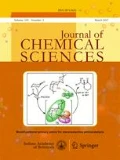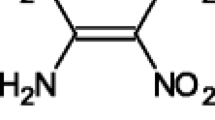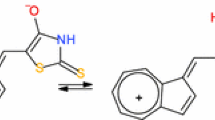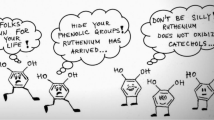Abstract
The reduction at the mercury electrode of a series of ruthenium(III) dithiocarbamates in dimethylsulphoxide (DMSO) has been investigated using D.C. A.C. polarography, chronoamperometry, coulometry (controlled potential electrolysis) and cyclic voltammetry. Tris(N,N-disubstituted dithiocarbamato) complexes of ruthenium exhibit two one-electron polarographic waves in the potential range 0.00 to 2.20 volt relative to Ag/AgClO4 (DMSO) reference electrode. The first reduction, at approximately — 0.950 volt, is quasi-reversible. The [Ru(II) (dAdtc)3]− complexes resulting from this reduction are susceptible to dissociation, releasing the free dialkyldithiocarbamate anion.
Similar content being viewed by others
References
Bond A M, Casey A T and Thackeray J R 1973Inorg. Chem. 12 887
Bond A M, Casey A T and Thackeray J R 1974Inorg. Chem. 13 84
Brinkoff H C 1971Rec. Trav. Chim. Pays-Bas 90 377
Cauquis G and Lackenal D 1973Inorg. Nucl. Chem. Lett. 9 1095
Duffy D J and Pignolet L H 1974Inorg. Chem. 13 2405
Feldberg S W and Jeftic L 1972J. Phys. Chem. 76 2439
Golding R M and Lehtonen K 1974Aust. J. Chem. 13 2083
Hendrickson A R, Hope J M and Martin R L 1976J. Chem. Soc. Dalton. Trans. Art. 2032
Malatesta L 1938Gazz. Chim. Ital. 68 195
Malatesta L 1940Gazz. Chim. Ital. 70 541
Mann C K. 1969Electroanal. Chem. 3 57
Mattson B M, Heiman J R and Pignolet L H 1976Inorg. Chem. 15 564
Nicholson R S and Shain I 1964Anal. Chem. 36 706
Randle T H, Cardwell T J and Magee R J 1975Aust. J. Chem. 28 21
Randle T H, Cardwell T J and Magee R J 1976Aust. J. Chem. 29 1191
Vinh Hoa H T and Magee R J 1979J. Inorg. Nucl. Chem. 41 351
Vlcek A A 1960Prog. Inorg. Chem. 5 211
Wheeler S H, Mattson B M, Miessler G L and Pignolet L H 1978Inorg. Chem. 17 340
Author information
Authors and Affiliations
Rights and permissions
About this article
Cite this article
Ahmed, M., Magee, R.J. The electrochemical behaviour of tris(N,N-disubstituted dithiocarbamato) complexes of ruthenium(III) in dimethylsulphoxide. Proc. Indian Acad. Sci. (Chem. Sci.) 88, 401–411 (1979). https://doi.org/10.1007/BF02843334
Received:
Issue Date:
DOI: https://doi.org/10.1007/BF02843334




